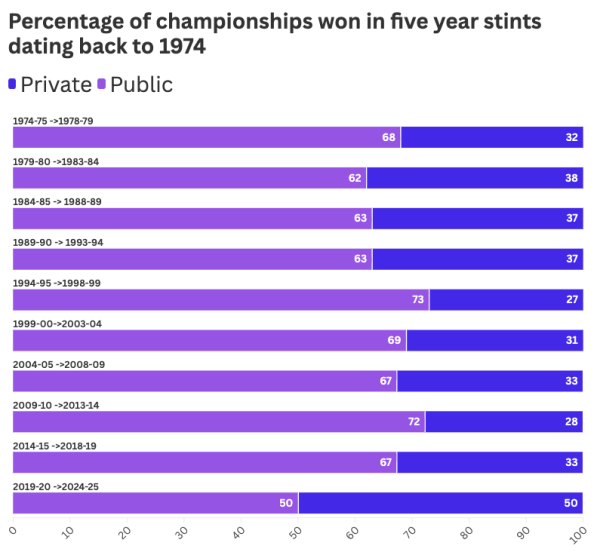There’s a real problem with high school football in Illinois, and it’s becoming impossible to ignore.
The 2024 IHSA football season wrapped up in late November at Illinois State’s Hancock Stadium with championship games across all eight divisions. Illinois’s high school football divisions are determined by each school’s average enrollment over the past two years, but also by the “success factor” – a system the IHSA introduced over a decade ago that moves teams up to a higher division than their enrollment would suggest if they’ve been particularly dominant in recent seasons.
In those eight championship games, private schools won seven of the eight titles. The only public school victory came in division 6A, where East St. Louis defeated Geneva in the only public vs. public matchup. Private schools didn’t just win, though – they ran the table this year. In the seven private vs. public school matchups, private schools outscored public schools 283-76.
Michael O’Brien, one of Illinois’s top high school sports journalists, summed up the weekend’s lopsided results in his final 2024 rankings:
“That won’t draw fans to high school sports or keep them engaged. It doesn’t matter if you support private schools or public schools, this weekend was bad for high school sports,” he wrote.
For years now, Catholic schools and a small number of non-denominational private schools have dominated Illinois high school football. In division 8A, Evanston’s division, Loyola just secured its third consecutive state title.
It’s frustrating. While ETHS hasn’t been a contender in recent seasons, this trend definitely trickles down to Evanston’s regular season games. Take this year’s blowout loss to St. Laurence, a private Catholic school, for example; Evanston scheduled that non-conference game before St. Laurence added three-star quarterback and Illinois State commit Chase Kwiatkowski, who transferred in from Lake Central High School (which, by the way, is in Indiana, but more on that later).
Recruiting for sports is prohibited at both public and private high schools, but private schools can more easily get around these restrictions. It’s a real problem.
To start with the obvious, public schools are bound by rigid zoning rules, while private schools in Illinois operate under much looser zoning laws. The only zoning regulation private schools face is that students must live within 30 miles of the school. For Loyola and other private schools in the general area, this essentially means that any student in the greater Chicagoland area could attend that school. Shockingly, the IHSA even allows students from other states to compete, as long as they live within that 30-mile radius, further broadening the pool for private schools.
For example, two years ago, Maine South (a public school in the CSL) got busted for using ineligible players who lived outside its district. As a result, Maine South had to forfeit their wins and was placed on probation. Private schools, with no rigid zoning restrictions, rarely have to face this problem.

That’s one clear advantage private schools have, but there are certainly more. Unfortunately, the specifics of how schools work around recruiting policies are convoluted and vary from school to school, making it hard to pin down exactly how private schools do it at large.
What I do know, though, is the outcome: private schools went seven for eight this year despite being the numeric minority by a significant amount in all eight divisions.
It hasn’t always been like this. While private schools have always punched above their weight in Illinois high school football, in recent years they have made significant jumps and are beginning to dominate the landscape even more like they did this year.
It’s really hard to look at this dominance and say that this is purely coincidental or due to “natural” factors. The lack of regulation in Illinois high school football is becoming problematic.










John Summins • Dec 13, 2024 at 10:10 pm
The 2 main advantages of Catholic/ private schools are discipline and greater intensity